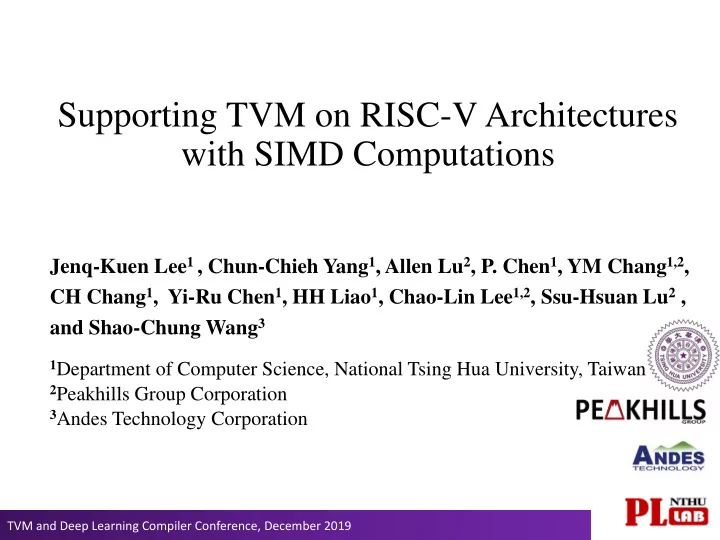

Supporting TVM on RISC-V Architectures with SIMD Computations Jenq-Kuen Lee 1 , Chun-Chieh Yang 1 , Allen Lu 2 , P. Chen 1 , YM Chang 1,2 , CH Chang 1 , Yi-Ru Chen 1 , HH Liao 1 , Chao-Lin Lee 1,2 , Ssu-Hsuan Lu 2 , and Shao-Chung Wang 3 1 Department of Computer Science, National Tsing Hua University, Taiwan 2 Peakhills Group Corporation 3 Andes Technology Corporation TVM and Deep Learning Compiler Conference, December 2019
RISC-V with two vector ISAs to support fall-back engine with AI Models Super Word Vector Packed Vector (SubWord SIMD) P Extension V Extension With Fixed-Point and Integer Instructions 0 8 e1 e1 e1 e1 Add 8, OP1 OP1 OP1 OP1 Sub Mul 16, 32, Compare e1 e1 e1 e1 64, Signed 128, Unsigned 256, 512, 1024 bits e1 e1 e1 e1 RISC-V DSP (P) Extension Proposal Chuan-Hua Chang, Andes Technology Corporation Courtesy: Vector ISA, Roger Espasa, Esperanto Technologies TVM and Deep Learning Compiler Conference, December 2019
[RFC] Fixed-point type implementation proposal #4446 • RISC-V P extension (Subword SIMD) with fixed- point instructions. • We refer Fxp as fixed-point value, Fp as floating-point value and PP as point position • Fxp = Fp * pow(2,PP) • Support Fixed-point Type with TVM = 1+ ¼ = 1.25 • Compiler time with type information for the binary point position of the variable. References for Fixed-Point Type (1) AC fixed-Point by Mentor graphics (https://www.mentor.com/hls- lp/downloads/ac-datatypes) (2) Our early proposal to Khronos for OpenCL fixed-point feature set (https://www.khronos.org/assets/uploads/developers/library/2018-khronos- group-opencl-embedded-outreach/Taipei-DSP-Profile-NTHU_Jan18.pdf) TVM and Deep Learning Compiler Conference, December 2019
Auto-FXP with TVM on RISC-V with p Extension • Using machine learning model to auto- tune the binary point position. • It can find the best binary point position for fixed-point expression when we have TVM on RISC-V with p extension. • The work extends AutoTVM and can enhance the accuracy while enjoy the low power numeric benefits. • The tuning work is done with spike simulator incorporated with RISC-V P Fxp16_12 by Default Fxp16_13 by Auto-FXP extension (Subword SIMD).
TVM for RISC-V with V Extension (Superword SIMD) • TVM Optimization • The TVM RISC-V codegen will lower SIMD computation with SIMD intrinsics into LLVM. • The LLVM backend will need to generate the corresponding SIMD instructions. • Need to tune the scheduler to provide a large loop index space for vector parallelism. • LLVM Optimization • VSETVL Redundancy Elimination • VMulADD Resource Utilization • Speedup based on runtime executed instructions Fast Vector Initializer Only TVM Optimization • Spike Simulator • assume 512 bits vector Speedup TVM+ LLVM Optimization 6 register • V SIMD in <4 x float32>, 5 • <8 x float32>, <16 x 4 float32> 3 • 2 Spec v0.7.0, TVM v0.6, 1 LLVM 9.0.0 • Compare with SIMD Densenet AVG Mobilenetv2 Lenet AlexNet float32 and no SIMD inceptionv3 Squeezenet1.0 Resnet18_v1 float32
Summary Thank you AWS team help with AI model validation flow. Look forward to contributing codes to the TVM source trees. More detailed of our work can also be found in the following. Experiments and AI Model Validations for Neo/TVM on RISC-V Architectures with SIMD, Allen Lu, et al, RISC-V Summit, San Jose, Dec 2019 (Poster). Enabling TVM on RISC-V Architectures with SIMD Instructions, Allen Lu, Chao-Lin Lee, Yuan-Ming Chang, Piyo Chen, Hsiang-Wei Sung, Heng Lin, Shao-Chung Wang, and Jenq-Kuen Lee, RISC-V Forum, March 2019 (Oral presentation).
Recommend
More recommend